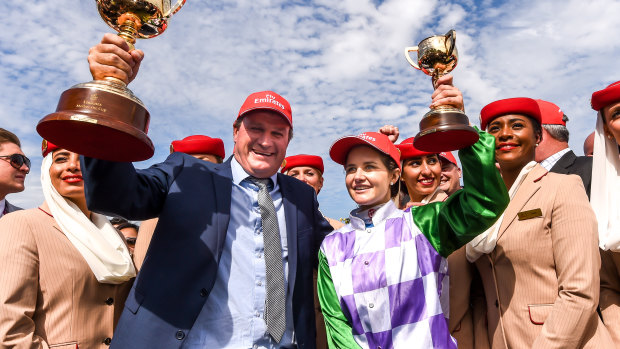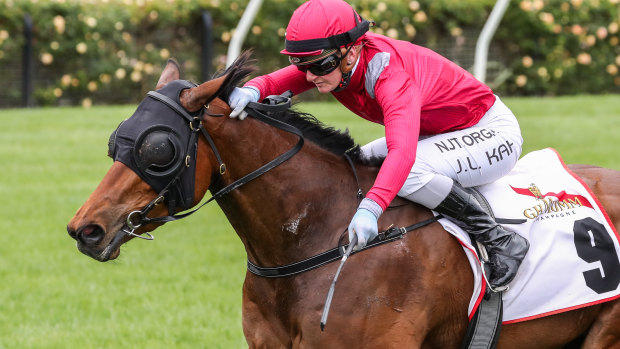This was published 4 years ago
Michelle Payne: five years on, what's changed?
Michelle Payne spent the day before her famous Melbourne Cup win neatly laying out her riding gear in a jockeys room she had to herself.
It was a nondescript race meeting at Cranbourne, the type which feeds racing's relentless beast and doesn't do much else. Payne had a couple of rides that day. If she wanted to share her thoughts and dreams about the upcoming Tuesday, the blank white walls might have listened.
These days at some race meetings in South Australia, men and women occasionally swap jockey rooms, more out of necessity. The girls are often represented in larger numbers than the boys, and squeeze into the space Payne had to herself.
But in the five years since Payne famously rode 100-1 hope Prince Of Penzance to victory and told the critics to "get stuffed", what else has changed?
This year, the only female jockey in the Melbourne Cup, South Australian-raised Jamie Kah, will also ride a horse starting from barrier one with "Prince" in his name.
Kah will partner the British-trained Prince Of Arran, a $10 chance with Sportsbet. The horse finished third in 2018 and second in 2019, and Kah will just be the third female to ride in the race since Payne's historic triumph (Katelyn Mallyon in 2016 and Kathy O'Hara in 2017 were the others).

Darren Weir and Michelle Payne after Prince of Penzance won the 2015 Melbourne Cup.Credit: Justin McManus
But while the omen bettors will have a flutter on Prince Of Arran, it's at the other end of the racing ladder in which Payne's circuitbreaker is being felt.
Almost one in three Australian jockeys are now female, significantly up from five years ago when it was hovering just above one in four. Yet it's at the entry level in which the Payne effect, in part, is working.
Women are now being represented at a greater proportion than men in apprentice programs throughout Australia, where young jockeys are indentured to a trainer and get a toehold in the industry.
While males are often destined for a longer career (females only make up about 10 per cent of the jockey population over 30), the fledgling jockey numbers are firmly weighted towards the fairer sex. At the time of Payne's history maker, only about 40 per cent of apprentice jockeys were female.
"And as the human population has got bigger, taller and stronger, they've well and truly filled the void in new jockeys coming through the system," NSW Jockeys Association chief executive Tony Crisafi said.
"In comparison to what happens in Europe and North America, the females here are given much more opportunity."
Australian Jockeys Association chairman Des O'Keeffe said the trend "will just keep going, and so it should".
When Kah, who is leading the Melbourne jockeys premiership this season, rode a remarkable four winners on Cox Plate day a little over a week ago, she was hailed as only the third jockey to do so.
There was no mention of being the first female to achieve the feat, just the third overall. It was considered a significant step in the right direction by many.

Jamie Kah rides Victoria Quay to victory in the Wakeful Stakes last weekend.Credit: Racing Photos
But when it comes to referencing female riders in form guides, why do the women still have "Ms" as a prefix?
"It's definitely time [for it to be removed]," AJA chief executive Martin Talty said. "They're all competing on equal terms, why do they have to carry a prefix and not the males?"
The honorific has previously been described as "draconian", and a review after Payne's win in late 2015 by Racing Australia, the industry's official record keeper, didn't mandate "Ms" be removed from the form guide.
But it ruled individual publications were free to determine whether they included the prefix or not. Many still carry it.
On Racing Australia's website on Monday afternoon, Kah had no honorific next to her name. But there was one before the name of Payne, who will ride in an earlier race on Cup day. Go figure.
What is certain is the impact Payne thinks her contemporary Kah can have on the industry, along with others like Sydney-based Rachel King, the first female to ride in The Everest, the world's richest turf race.
"She's such a beautiful rider and is really pretty to watch," Payne said of Kah. "I felt a lot of the battle we had was to try to prove we were as strong as the boys. You had to look as strong as the boys.
"Jamie is so effective, she's so balanced and poised, but doesn't override them. She's just lovely to watch. I think that's something that is really important. I think she can really change the game for female riders in the future."
In Kah's home state of South Australia, 16 of the 40 jockeys are now female. At the Boxing Day meeting last year at Nhill, halfway between Adelaide and Melbourne on the Victorian side of the border, Jeff Maund was the only male jockey there as he competed against seven women riders.
A few years ago Payne went on holidays with Kah and another jockey, the now retired Nikita Berriman. They went to the United States and briefly chatted about the state of the Australian jockey system, before Payne's life was made into a box office movie.
"It's important to remember those who paved the way before us," Payne said. "It's so much different to what we had, and then there were the girls before us. They were the real pioneers who paved the way for us, it's really important to remember that. It's changing, and in a big way as well."